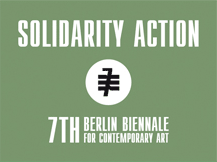In the last few years the Swiss Institute in Rome has instigated initiatives designed to open up a dialogue between the lively artistic world of Rome and the flourishing situation in Switzerland, with its variety of institutional levels, independently-run spaces and both young and less young artists. The whole approach is firmly anchored in a perspective which takes into account also the numerous experiences across Europe. This is also the driving spirit of P/Act for Art in Rome, a journal which originates from the collaboration between our institution and the 7th Berlin Biennale, in order to discuss on an international level themes related to cultural production as well as to the role of art and its institutions in a moment of profound transformations. The extremely vibrant scene which characterise cities such as Zurich and Geneva, results from policies of cross-sectional fundings that allow to sustain local artists through considerable resources, particularly if compared with the current broader European context. Notwithstanding all the criticisms often formulated in public debates, it remains fundamental that the financing of artistic production should be an act similar to the watering of a fertile ground, even if there must be full recognition of the inevitable risk that some of this support will not pay off. Only such a non-discriminatory approach creates the conditions favourable to the emergence of most unexpected talents. At the same time, institutions must be able to supply also the resources and fuel necessary projects to further bring to the fore talent and excellence in young artists. In order to foster a vital and prolific cultural environment, an art institution must therefore be capable of sustaining both phases, making different sorts of investments, simultaneously cross-sectional and specific, complementary rather than exclusive. Such a model should never be renounced, even if the currently fashionable criteria of efficiency push in another direction.
The core of such a model in Switzerland, is the focus upon the local dimension, capable of redefining citizenship also in a globalised context, as a direct expression of the space which everyone of us inhabits, be a small urban centre or a city. It is this very dimension upon which art institutions should be founded upon and which they should represent. In this respect, federalism is a strategic resource with the capacity to transform individual regions in a fertile environment. Switzerland with its four languages, is a constellation of specific realities which all have their own live and which cannot be homogenized or absorbed one into the other. Even though this local specificity is occasionally difficult to convey to a general public because it cannot be easily simplified, or tends to make the implementation of uniform cultural policies difficult, this dimension remains an important resource, an extraordinary reservoir of excellence which is continuously fuelled by young local artists. It is along these lines that one must begin thinking about the construction of networks which cross national boundaries, anchored in local specificities capable of speaking different languages and, at the same time, shaping forms of original mobility. Starting from the differences, from a first degree of heterogeneous productivity, one can create something new. With this journal I would like to consider the aspects of cultural policies that we have just described, as a model to seize the possibilities that the present offers in Italy as well as Europe. However, in order to understand the current support given to artistic production and the usefulness of valorising the new generation, we must go back to the beginning of the 1980s which in Zurich was a kind of second ’68. During these years there was intense protest against the distribution of funding – almost entirely concentrated in institutionalised culture with insufficient attention paid to the young and to artistic experimentation. The re-opening of the Opera Theatre, together with the allocation of considerable funding to opera, triggered an intransigent youth movement that pervaded the entire city, creating a harsh and painful climate, for everyone. These heavy social tensions profoundly shook the cultural establishment, forcing it to recalibrate the strategies of cultural policies. Without these protests Zurich would not be the city which we know today. The conflictual experiences of the 1980s paved the way for the transformation of the city into a reality at once open, dynamic, effervescent and maybe also less zwinglian. During the mini revolution of the 1980s, rather than looking inwards, institutions had the courage to re-invent themselves, giving new space to youth who were rebelling, for example by supporting the Jugendhaus.
In the seven years as director of the Swiss Institute in Rome, I have had the opportunity to become closely acquainted with Rome – an extraordinary metropolis with a uniquely rich history as well as an unparelled number of foreign institutes and academies. With the contribution of the then assessor responsible for cultural policies Umberto Croppi, Rome has gradually become more and more connected to these spaces; spaces that have the potential to significantly contribute to public debate and the development of the eternal city. However, Rome has now for quite some time been experiencing a difficult crisis which has become even more acute in the last few years with a dramatic lack of funds to invest in art and cultural production in general. And yet, in a context of profound difficulty and disillusionment, I see the emergence of a rich fermentation which today can be a fountain of inspiration. Rome is anything but lazy and lacking in energy, rather it is metropolis where interesting experiments are looking for new anchoring points and treading original paths. This climate – between heavy cuts and renewed vitality – represents an intellectual challenge for the entire art world. I hope that in such a context, this journal may make a useful contribution as an instrument of both discussion and research.
CHRISTOPH RIEDWEG
Director of Istituto Svizzero di Roma.


